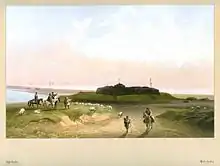Arabat Fortress
The Arabat Fortress is located at the southernmost part of Arabat Spit. Its name originates from either Arabic "rabat" meaning a "military post" or Turkic "arabat" meaning a "suburb"[1] and is the origin of the name of the Arabat Spit.[2] Its purpose was to guard the spit and Crimea from invasions.[3] The fortress was built around 17th century by the Turkish army and was first mentioned by the French Engineer and cartographer Guillaume Le Vasseur de Beauplan in 1660 in his book "Description d'Ukranie".[4]


The fortress had an advanced military design with octagonal shape and 3-meter thick stone walls surrounded by an earthen wall and a moat. It contained five towers and two gates. Several rows of arrowslits faced east, north and west and were designed for various artillery types. Whereas the fortress was hard to conquer when properly defended, due to its remote location from Turkey, its garrison was often understaffed and defended by the Russian army in 1737 and 1771. After Crimea became part of Russia the fortress was abandoned, but later refurbished and used by Russians during the Crimean War of 1853–1856 to defend the Crimean coast. After the war, the fortress was abandoned again and its walls were used by locals as a source of stone. The fortress was an area of heavy fighting between the Soviet Red Army and the White Army in 1920 and the German Army during the World War II in 1941–1944.[5] In 1968, some scenes of a famous Soviet movie Two Comrades Were Serving was filmed there.[1] Google Earth satellite imagery shows the fort has been occupied by military forces since the Annexation of Crimea by the Russian Federation in 2014.
References
| Wikimedia Commons has media related to Arabat Fortress. |
- Arabat Foretress Archived 2014-03-23 at the Wayback Machine (in Russian)
- Shutov, Introduction Archived 2013-02-04 at the Wayback Machine
- Semenov, p.111
- Guillaume Le Vasseur de Beauplan (1660). Description d'Ukranie (in French).
- Shutov, Part 1 Archived 2013-02-04 at the Wayback Machine
